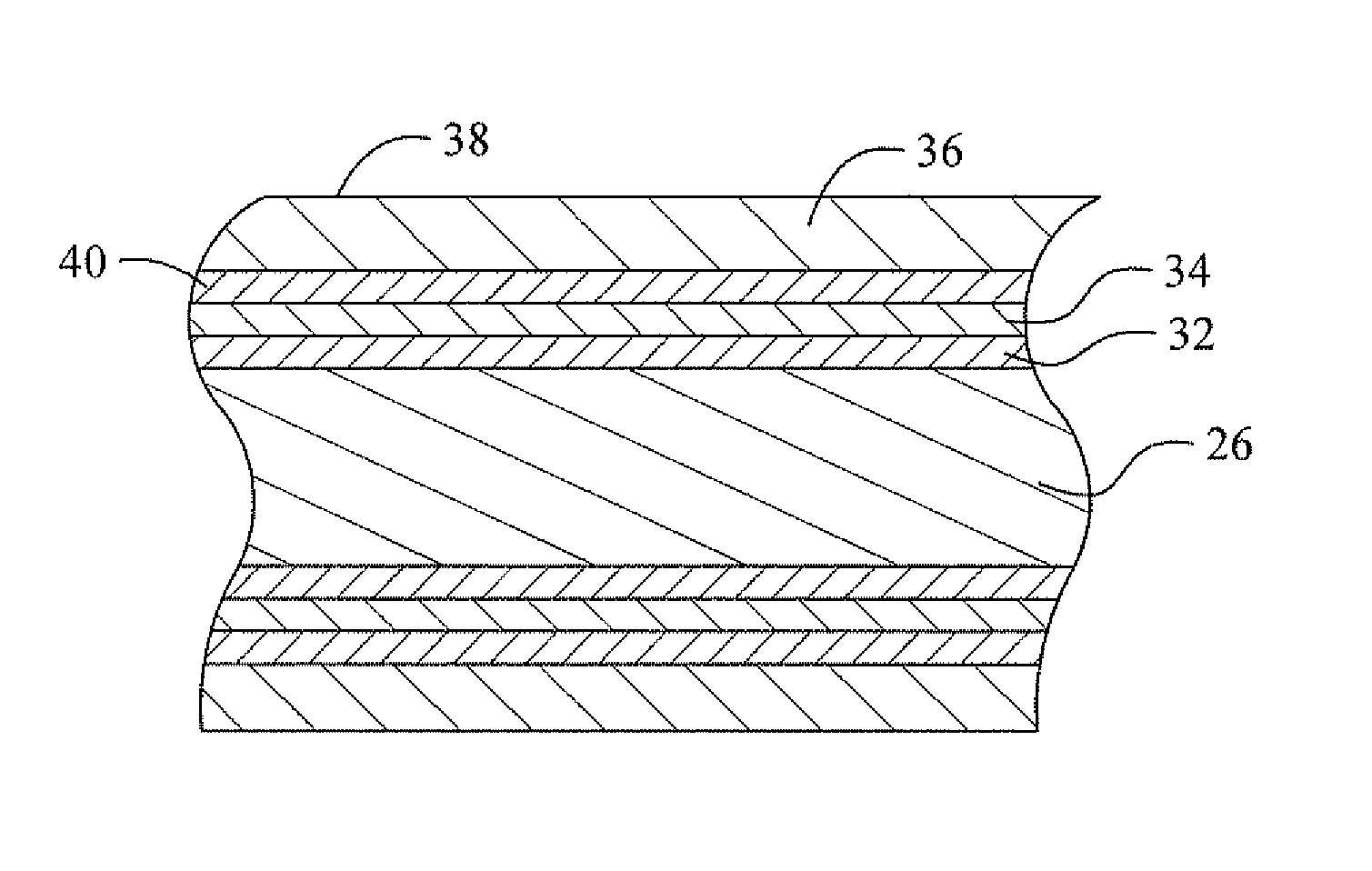Fretting and whisker resistant coating system and method
a technology of whisker and coating system, applied in the direction of surface reaction electrolytic coating, non-conductive material with dispersed conductive material, solid-state devices, etc., can solve the problems of reducing the performance of electrical devices, reducing the wettability of solder, and easy oxidation and tarnish, so as to minimize the increase of resistivity
- Summary
- Abstract
- Description
- Claims
- Application Information
AI Technical Summary
Benefits of technology
Problems solved by technology
Method used
Image
Examples
example 1
Tin Whiskering
[0075]Coupons 2 inches×0.5 inch×0.010 inch thick were cut from a strip of copper alloy C194. Copper alloy C194 has a composition by weight of 2.1% / -2.6% iron, 0.05%-0.20% zinc, 0.015%-0.15% phosphorous and the balance is copper. The coupons were cleaned in a commercial alkaline cleaner at 50° C. using a cathodic current density of 15 asf (amps per square foot) for 1 minute.
[0076]Referring to Table 2, when a nickel layer was deposited, deposition was by electroplating. The Ni plating solution was an aqueous solution containing from about 60 to 75 g / l (grams per liter) Ni as Ni sulfamate, about 6 to 8 g / l NiCl2, and about 38 to 53 g / l boric acid at 53° C. with a pH between about 3.5 and 4.2. The Ni plating conditions were 30 asf for about 60 seconds.
[0077]When a copper layer was deposited, deposition was by electroplating from an aqueous solution containing about 20 to 70 g / l Cu and about 50 to 200 g / l H2SO4 at 40-60° C. using a current density of 40 asf for about 40 sec...
example 2
Fretting Wear Impact on Contact Resistance
[0083]Coupons having the dimensions 6 inches by 1.25 inches by 0.005 inch were formed from copper alloys C194 and C7025, has a composition, by weight, of 2.2%-4.2% nickel, 0.25%-1.2% silicon, 0.05%-0.3% Mg and the balance is copper.
[0084]The copper alloy coupons were coated with intervening layers and matte tin as in Example 1 except that the silver layer was deposited by the immersion method using MacDermid Sterling™ silver solution and the tin was deposited from a sulfate solution containing 20 g / l to 80 g / l of tin ions as SnSO4 50 g / l to 200 g / l sulfuric acid, and organic additives.
[0085]The impact of fretting wear on contact resistance was determined by moving a ¼″ diameter bump at 5 Hz up to 20,000 cycles with a cycle length of 20 μm across a contact surface to be tested. A normal force of 100 g was applied to the bump, and contact resistance data was collected while the bump was in motion. The values reported are the number of cycles ...
example 3
Coefficient of Friction
[0090]Copper alloy C194 coupons having the dimensions 6 inch×1.25 inch×0.005 inch were coated with intervening layers and matte tin as in the preceding examples. A reflowed tin surface was obtained by heating a sample to 350° C. in air and quenching in water.
[0091]The coefficient of friction was measure as the ratio of the resistive force relative to the normal force (R / N) when a ¼ inch diameter bump slid at 3 mm / sec for 10 cycles across a tin coated flat surface. The normal force was loaded as dead weight and no lubricant was applied between the tin coated surface and the bump. The resistive force was measured as the bump was slid against the flat surface of the sample. The value reported was the average of all 10 cycles. A lower R / N indicates less friction. The results are reported in Table 4.
[0092]
TABLE 4InterveningLayers -Thickness inTinR / NμinchThickness0-60 mmSampleCuAgTin Typeμinch100 g250 g120-40-0-Matte40-800.550.55220-402-5Matte40-800.580.53320-40 5-...
PUM
| Property | Measurement | Unit |
|---|---|---|
| temperature | aaaaa | aaaaa |
| thickness | aaaaa | aaaaa |
| thickness | aaaaa | aaaaa |
Abstract
Description
Claims
Application Information
 Login to View More
Login to View More - R&D
- Intellectual Property
- Life Sciences
- Materials
- Tech Scout
- Unparalleled Data Quality
- Higher Quality Content
- 60% Fewer Hallucinations
Browse by: Latest US Patents, China's latest patents, Technical Efficacy Thesaurus, Application Domain, Technology Topic, Popular Technical Reports.
© 2025 PatSnap. All rights reserved.Legal|Privacy policy|Modern Slavery Act Transparency Statement|Sitemap|About US| Contact US: help@patsnap.com



